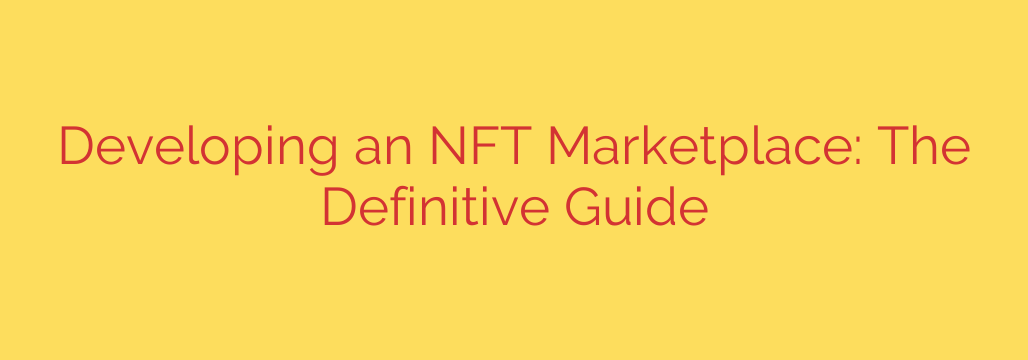
Unlock the Digital Art Revolution: Your Guide to Building a High-Performance NFT Marketplace
The rise of Non-Fungible Tokens (NFTs) has fundamentally changed how we perceive digital ownership and value. At the heart of this transformation are NFT marketplaces – platforms where creators can mint, showcase, and sell their unique digital assets, and collectors can discover and acquire them. Building such a platform is a complex but potentially highly rewarding endeavor, requiring a deep understanding of blockchain technology, development practices, and user experience design.
Embarking on the journey to create an NFT marketplace means navigating a multi-faceted process. It’s not simply about building a website; it’s about establishing a secure, scalable, and user-friendly ecosystem for digital asset trading.
Essential Components of an NFT Marketplace
A successful NFT marketplace requires a robust set of features to facilitate seamless interactions between creators and collectors. Key functionalities include:
- User Authentication and Profiles: Secure ways for users to sign up, manage their profiles, and connect their digital wallets.
- Marketplace Listings: Displaying NFTs with detailed information like title, description, creator, owner, price history, and rarity traits.
- Minting Capabilities: Allowing creators to easily upload their digital files (art, music, videos, etc.) and convert them into NFTs on a chosen blockchain.
- Buying and Selling Mechanisms: Supporting various transaction types, such as fixed-price sales and auction systems (timed or English auctions).
- Wallet Integration: Seamless connection with popular cryptocurrency wallets (like MetaMask, WalletConnect, etc.) for managing assets and transactions.
- Search and Filtering: Advanced options allowing users to easily find specific NFTs based on categories, price range, creator, status (buy now, on auction), and other attributes.
- Smart Contracts: The backbone of the marketplace, automating token minting, ownership transfers, and transaction payouts securely on the blockchain.
- Admin Panel: Tools for platform administrators to manage users, moderate listings, track transactions, and configure settings.
The Technical Foundation
Building an NFT marketplace sits at the intersection of traditional web development and cutting-edge blockchain technology. The core technical considerations involve:
- Blockchain Selection: Choosing the underlying blockchain network (e.g., Ethereum, Polygon, Solana, Binance Smart Chain) based on factors like transaction speed, gas fees, security, and ecosystem maturity.
- Smart Contract Development: Writing, deploying, and auditing the smart contracts that govern NFT creation (using standards like ERC-721 or ERC-1155) and marketplace logic. Smart contract security audits are non-negotiable.
- Decentralized Storage: Utilizing systems like IPFS (InterPlanetary File System) to store the actual digital assets and their metadata in a decentralized manner, linked via the NFT’s token URI.
- Backend Development: Building the server-side logic, APIs, and database infrastructure to handle user management, listings, off-chain data, and interactions with the blockchain nodes.
- Frontend Development: Creating the user interface (UI) and user experience (UX) that makes the platform intuitive, visually appealing, and easy to navigate on various devices.
The Development Journey
Creating an NFT marketplace is typically a phased approach:
- Planning and Strategy: Defining the marketplace niche, target audience, core features, blockchain choice, and monetization model (e.g., transaction fees, listing fees).
- UI/UX Design: Designing a user-centric interface that simplifies complex blockchain interactions and provides a smooth experience.
- Smart Contract Development & Audit: Writing, testing, and getting smart contracts professionally audited for vulnerabilities. Prioritize security audits rigorously.
- Backend and API Development: Building the server infrastructure to support the frontend and interact with the blockchain.
- Frontend Development: Bringing the design to life, connecting it to the backend and wallet integrations.
- Integration: Connecting all components – frontend, backend, smart contracts, and external wallets.
- Testing: Comprehensive testing covering functionality, security, performance, and user flows.
- Deployment: Launching the marketplace onto the chosen blockchain and web hosting.
- Maintenance and Updates: Ongoing monitoring, bug fixes, feature enhancements, and security patches.
Key Considerations for Success
Beyond the technical build, several factors are crucial for long-term success:
- Security: Given the financial nature of transactions and ownership, robust security measures are paramount. This includes secure coding practices, regular audits, and educating users on wallet security.
- User Experience (UX): Simplify the process of minting, buying, and selling. Abstract away unnecessary blockchain complexities for average users.
- Scalability: Design the architecture to handle increasing transaction volumes and user growth.
- Community Building: Fostering a vibrant community of creators and collectors is essential for liquidity and platform growth.
- Legal and Compliance: Understand the evolving regulatory landscape around NFTs and digital assets in your target markets.
Building an NFT marketplace is a significant undertaking that requires expertise across blockchain technology, software development, design, and market strategy. By focusing on a strong technical foundation, essential features, robust security, and a positive user experience, you can create a platform ready to thrive in the dynamic world of digital assets.
Source: https://kifarunix.com/how-to-develop-an-nft-marketplace-a-comprehensive-guide/








